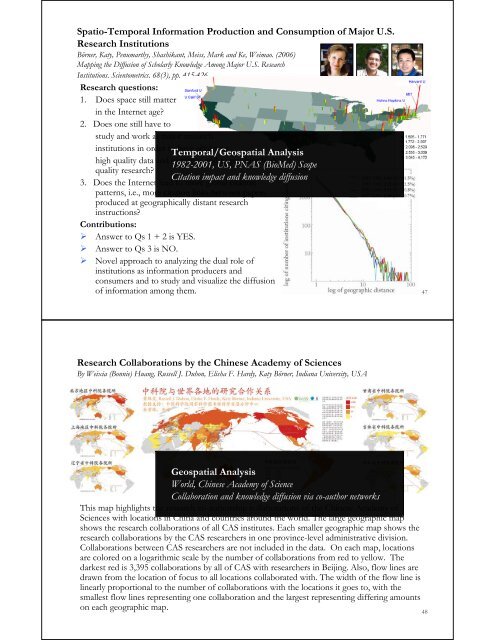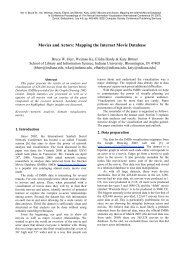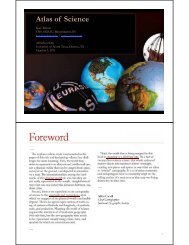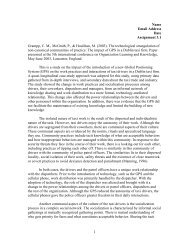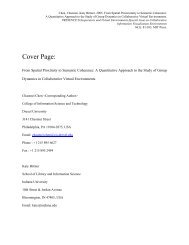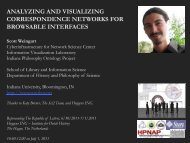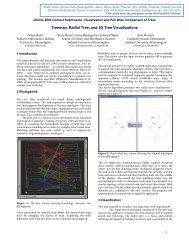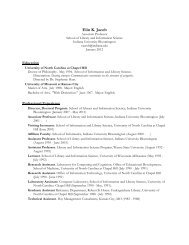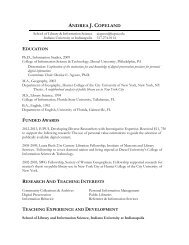The Science of Science (Sci2) Tool and Its Utility for Research ... - VW
The Science of Science (Sci2) Tool and Its Utility for Research ... - VW
The Science of Science (Sci2) Tool and Its Utility for Research ... - VW
- No tags were found...
You also want an ePaper? Increase the reach of your titles
YUMPU automatically turns print PDFs into web optimized ePapers that Google loves.
Spatio-Temporal In<strong>for</strong>mation Production <strong>and</strong> Consumption <strong>of</strong> Major U.S.<strong>Research</strong> InstitutionsBörner, Katy, Penumarthy, Shashikant, Meiss, Mark <strong>and</strong> Ke, Weimao. (2006)Mapping the Diffusion <strong>of</strong> Scholarly Knowledge Among Major U.S. <strong>Research</strong>Institutions. Scientometrics. 68(3), pp. 415-426.<strong>Research</strong> questions:1. Does space still matterin the Internet age?2. Does one still have tostudy <strong>and</strong> work at major researchinstitutions in order toTemporal/Geospatialhave access toAnalysishigh quality data <strong>and</strong> expertise1982-2001,<strong>and</strong>US,to producePNAShigh(BioMed) Scopequality research?Citation impact <strong>and</strong> knowledge diffusion3. Does the Internet lead to more global citationpatterns, i.e., more citation links between papersproduced at geographically distant researchinstructions?Contributions:‣ Answer to Qs 1 + 2 is YES.‣ Answer to Qs 3 is NO.‣ Novel approach to analyzing the dual role <strong>of</strong>institutions as in<strong>for</strong>mation producers <strong>and</strong>consumers <strong>and</strong> to study <strong>and</strong> visualize the diffusion<strong>of</strong> in<strong>for</strong>mation among them.47<strong>Research</strong> Collaborations by the Chinese Academy <strong>of</strong> <strong>Science</strong>sBy Weixia (Bonnie) Huang, Russell J. Duhon, Elisha F. Hardy, Katy Börner, Indiana University, USAGeospatial AnalysisWorld, Chinese Academy <strong>of</strong> <strong>Science</strong>Collaboration <strong>and</strong> knowledge diffusion via co-author networksThis map highlights the research co-authorship collaborations <strong>of</strong> the Chinese Academy <strong>of</strong><strong>Science</strong>s with locations in China <strong>and</strong> countries around the world. <strong>The</strong> large geographic mapshows the research collaborations <strong>of</strong> all CAS institutes. Each smaller geographic map shows theresearch collaborations by the CAS researchers in one province-level administrative division.Collaborations between CAS researchers are not included in the data. On each map, locationsare colored on a logarithmic scale by the number <strong>of</strong> collaborations from red to yellow. <strong>The</strong>darkest red is 3,395 collaborations by all <strong>of</strong> CAS with researchers in Beijing. Also, flow lines aredrawn from the location <strong>of</strong> focus to all locations collaborated with. <strong>The</strong> width <strong>of</strong> the flow line islinearly proportional to the number <strong>of</strong> collaborations with the locations it goes to, with thesmallest flow lines representing one collaboration <strong>and</strong> the largest representing differing amountson each geographic map.48


